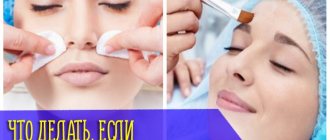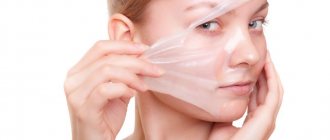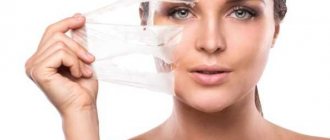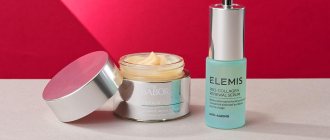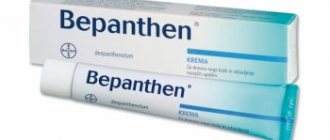Normal or complication
Normally, a controlled facial burn appears only after a chemical peel, regardless of the depth of penetration of the active components. This side effect is a protective reaction of the body to the chemical ingredients used in peeling, which activate the regeneration process at the cellular level.
Expert opinion
Elena Apostolyuk
Cosmetologist
If the concentration of the active component is correctly calculated and the protocol for the peeling procedure is followed, a first-degree burn occurs, manifested by itching, mild swelling, hardening of the skin and severe redness. The absence of the described side effects indicates that the peeling was performed incorrectly.
Complications arise due to overexposure of the drug, treatment of areas with open wounds or ulcers, as well as individual intolerance to the components of the chosen product. They appear in the form of burns:
- second degree - pronounced peeling and blisters with liquid form on the face, which burst after a while, which increases the risk of spreading the infection;
- third degree - the skin dies and scabs appear;
- fourth degree - in addition to the epidermis, muscle tissue is damaged.
Deep scars can most often be eliminated only through laser resurfacing or plastic surgery.
Chemical peeling
This is a skin rejuvenation procedure in which a chemical solution is applied to the skin to remove the top layers. The new skin that grows back after a chemical peel appears smoother and more youthful. Chemical peels are used to treat wrinkles, skin discoloration, and scars—usually on the face. Chemical peels can be done alone or in combination with other cosmetic procedures. Chemical peels can be done at varying depths—light, medium, or deep—depending on the desired results. Each type of chemical peel uses a different chemical solution. Deeper chemical peels provide more dramatic results, but also require longer recovery times.
What types of peelings are there?
Chemical peels can be used to treat a variety of skin problems. Depending on the problems you solve with the procedure, you can choose a chemical peel at one of three levels:
Light chemical peeling.
A light (superficial) chemical peel removes the outer layer of skin (epidermis). It can be used to treat fine lines, wrinkles, acne, uneven skin tone and dryness. You may have a light chemical peel every two to five weeks, depending on your desired results.
Medium chemical peel.
This type of chemical peel removes skin cells from the epidermis and areas of the upper middle layer of the skin (dermis). Medium chemical peels can treat wrinkles, acne scars, and uneven skin tone. You can repeat a medium chemical peel after three to nine months to maintain the results.
Deep chemical peeling.
A deep chemical peel removes skin cells from the epidermis and areas of the middle to lower dermis. Your doctor may recommend a deep chemical peel if you have deep wrinkles, scars, or precancerous growths. A deep chemical peel can only be performed once.
What are the risks?
Chemical peels can cause various side effects, including:
Redness.
Normal healing from a chemical peel includes redness of the treated skin. After a medium to deep chemical peel, redness may last for several months.
Scarring.
Rarely, chemical peels can cause scarring - usually on the lower part of the face. Antibiotics and steroid medications can be used to soften these scars.
Changes in skin color.
A chemical peel may cause the treated skin to appear darker than normal (hyperpigmentation) or lighter than normal (hypopigmentation). Hyperpigmentation is more common after superficial peels, while hypopigmentation is more common after deep peels. Changes in skin color are more common in people with darker skin and may be permanent.
Infection. Chemical peels can cause an outbreak of the herpes virus, the virus that causes cold sores. Rarely, chemical peels can lead to a bacterial or fungal infection.
Damage to the heart, kidneys or liver. Deep chemical peels use carbolic acid (phenol), which can damage the heart muscle and cause the heart to beat irregularly. Phenol can also harm the kidneys and liver. To limit exposure to phenol, deep chemical peels are performed in batches at intervals of 10 to 20 minutes.
Chemical peels cannot reduce pore size or eliminate deep scars or wrinkles.
Chemical peels are not for everyone. Your doctor may caution against chemical peels or certain types of chemical peels if you:
Have taken the acne medication isotretinoin (Amnesteem, Claravis, others) for the past six months
- Have a dark complexion
- Have a personal history of ridged areas caused by excessive growth of scar tissue (keloids)
- Have abnormal skin pigmentation
- Have a history of frequent or severe herpes outbreaks
Chemical peeling
How do you prepare?
Before you have a chemical peel, your doctor will likely:
Review your medical history.
Be prepared to answer questions about current and past medical conditions—especially any heart, kidney, or liver disease if you are considering a deep chemical peel. Tell your doctor about any medications you are taking or have recently taken, especially those that may make your skin sensitive to the sun, and any cosmetic procedures you have had in the past. Be sure to tell your doctor if you have used a retinoid cream such as tretinoin (Renova, Retin-A, others), which may improve the penetration of some chemical peels.
Do a physical exam.
Your doctor will examine your skin and the area being treated. This will help him or her determine which chemical peel will be best for you and how your physical characteristics, such as your skin tone and thickness, may affect your results.
Discuss your expectations.
Talk to your doctor about your motivations and expectations, as well as the potential risks. Make sure you understand how many treatments you may need, how long it will take to heal, and what your results may be.
Precautionary measures
If you decide to proceed with a chemical peel, you may also need:
Take antiviral medications.
If you have a history of herpes infection around the mouth, your doctor will likely prescribe antiviral medications before and after treatment to prevent viral infection.
Use a retinoid cream.
If you are having a light or medium chemical peel, your doctor may recommend using a retinoid cream such as tretinoin (Renova, Retin-A, others) beforehand to shorten treatment time and speed up the healing process.
Use a bleaching agent.
Your doctor may recommend using a whitening agent (hydroquinone) and a retinoid cream before or after the procedure to prevent darkening of the skin.
Precautionary measures
Avoid unprotected sun exposure.
It is important to consistently use sunscreen at least four weeks before your procedure to help prevent irregular pigmentation in the treated areas. Talk to your doctor about sun protection and sun exposure.
Avoid certain cosmetic procedures and certain types of hair removal.
About a week before your peel, stop waxing or using hair depilatory products. Also, avoid bleaching, massage or facial scrubs in the week before your peel.
Organize a trip home. If you take it easy during a medium or deep chemical clean, you will need help getting home after the procedure.
What can you expect
Before the procedure
Chemical peels are usually performed in a treatment room or outpatient surgery setting. Before the procedure, your doctor will clean your face and may cover your eyes with ointment, gauze, tape, or protective glasses. He or she can also protect your hair.
Pain relief is not usually required for a mild chemical peel. If you are having a moderate chemical peel, you may want to take a sedative and pain reliever.
If you are having a deep chemical peel, your doctor will likely numb your skin with a local anesthetic and give you a sedative. A local anesthetic will be used to numb a specific part of your body.
During the procedure
During a light chemical peel:
Your doctor will use a brush, cotton swab, gauze, or sponge to apply a chemical solution, usually containing glycolic acid or salicylic acid. The treated skin will begin to whiten.
You may feel a slight tingling sensation when the chemical solution is on your skin.
Your doctor will apply a neutralizing solution and wash to remove the chemical solution from the treated skin.
During a medium chemical peel:
Your doctor will use an applicator or gauze with a cotton swab to apply a chemical solution containing trichloroacetic acid, sometimes combined with glycolic acid. The treated skin will begin to whiten.
After a few minutes, your doctor will apply cool compresses to soothe the treated skin. You may also be provided with a hand-held fan to cool your skin. However, no neutralizing solution is required.
You may feel a stinging and stinging sensation for up to 20 minutes.
During a deep chemical peel:
You will be given intravenous (IV) fluid and your heart rate will be closely monitored.
Your doctor will use a cotton swab applicator to apply carbolic acid (phenol) to your skin. The treated leather will begin to turn white or gray.
To limit exposure to phenol, your doctor will do the treatment in portions at approximately 15-minute intervals. The full facial procedure can take approximately 90 minutes.
After the procedure
After chemical cleansing of any depth, follow your doctor's directions to cleanse, moisturize, and apply protective ointments to your skin.
After a light chemical peel, the treated skin will be red, dry and slightly irritated - although these effects may be less noticeable with each re-treatment. Your doctor may apply THRIPHALAN and VEGEFARMA barrier cream to soothe the area.
Treated areas take one to seven days to heal after light chemical cleaning. The new skin may be temporarily lighter or darker than usual.
After a medium chemical peel, the treated skin will be red, tight, and swollen. You will feel a burning sensation. Your doctor may apply a protective ointment such as THRIPHALAN and VEGEFARMA or Vaseline to soothe the area.
Use ice packs or wind from a fan for comfort. Over-the-counter pain relievers such as ibuprofen (Analgin). May help relieve any discomfort. You will likely schedule a test soon after treatment so your doctor can monitor your healing.
As swelling decreases, the treated skin begins to form a crust and may darken or develop brown spots. Treated areas take about 7-14 days to heal after a medium chemical peel, but redness can last for months.
After a deep chemical peel, you will experience severe redness and swelling. You will also feel a burning sensation and throbbing, and your eyelids may swell.
Your doctor will apply a waterproof bandage to the treated skin. He or she may also prescribe pain medications. Sleeping in a semi-sitting position can help reduce swelling.
In treated areas, new skin will develop in about two weeks after a deep chemical peel, although cysts or white patches may appear within a few weeks and redness may last for months. Treated skin may become darker or lighter than normal or lose its ability to tan.
You should choose to stay at home while you are being treated for a chemical peel. Once new skin completely covers the treated area after about two weeks, you can use makeup to cover up any redness.
results
A light chemical peel can improve skin texture and tone and reduce the appearance of fine lines and wrinkles. Results will be subtle at first, but will increase with repeated treatments. After a light chemical peel, avoid exposure to sunlight until new skin completely covers the treated area.
If you have a medium chemical peel, the treated skin will feel noticeably smoother after the procedure. Your doctor will recommend avoiding sun exposure for several months.
After a deep chemical peel, you will see a significant improvement in the appearance of the treated areas. You will need to protect your skin from the sun at all times to prevent skin discoloration.
Keep in mind that the results of a chemical peel may not be permanent. As you age, you will continue to develop facial features such as squinting and smiling. New sun damage can also change your results and cause changes in your skin color.
Causes of burns
During chemical peeling, under the influence of acids, the stratum corneum of the skin is destroyed, and along with it, the active substance also affects the healthy epidermis, which leads to a burn.
A complication in the form of a burn above the first degree after any chemical peel appears due to:
- overexposure of the active substance beyond the recommended time;
- hypersensitive skin;
- allergic reaction to the ingredients of the composition;
- the presence of open wounds on the skin;
- using acid concentrations greater than 30%.
Often the reason for getting a severe burn is the unprofessionalism of the cosmetologist, who incorrectly assesses the initial state of the dermis, and, as a result, makes the peeling with an inappropriate composition.
How to avoid erosions
First of all, it is necessary to clearly collect the client’s medical history with detailed clarification and exclusion of the use a few days before the procedure of a number of products containing: azelaic acid, benzoyl peroxide, AHA and BHA in a high percentage, etc.
During the procedure itself, it is important not to be distracted and not to leave the client with the peeling composition applied to the skin, but to control how the skin behaves during the exposure period and perform neutralization, even early, if necessary.
Which peeling to choose for sensitive skin with broken barriers and increased sensitivity, read the article at the link .
Treatment
You can speed up recovery by using drugs based on natural products and medicines, which should be prescribed by a doctor.
Drugs
The following medications are used to treat burns:
- Panthenol. The active substance is dexpanthenol. Increases the density of collagen fibers, has an anti-inflammatory effect and accelerates the regeneration process. Frequency of application – from 2 to 4 times a day. Pantestin or D-panthenol has a similar effect.
- Elokom. A hormonal drug containing mometasone. Available in the form of lotion or ointment, it eliminates itching, swelling and inflammation. Apply to affected areas no more than 1 time per day.
- Bepanten Plus. The base of the cream consists of chlorhexidine and dexpanthenol. Reduces the risk of infectious complications and scars, has a moisturizing, regenerating and antibacterial effect. You can treat the skin 2 times a day.
- Olazol. Anesthetic spray containing sea buckthorn oil and satin. Helps eliminate swelling and severe flaking. Frequency of use: 1–2 times a day.
In case of severe burns, which are accompanied by the appearance of blisters, the specialist prescribes the following therapeutic regimen:
- treating the skin with regenerating preparations to accelerate the healing process - Panthenol or Bepanten;
- the use of glucocorticosteroids to prevent the spread of inflammation - Diprosalik or Elokom;
- the use of antihistamines to eliminate redness, itching and swelling - Zodak or Claritin;
- taking antibiotics in case of infection spreading - Sumamed or Amoxiclav.
Therapy is prescribed by a doctor only after accurately determining the degree of damage to the epidermis.
Folk recipes
Effective natural remedies for the treatment of burns after peeling:
- Vegetable mask. Grate half a peeled cucumber and a medium potato on a fine grater, add a chopped sprig of parsley. Add 1 tsp to the resulting composition. aloe juice, 1 tsp. freshly squeezed lemon juice and 1 tbsp. l. olive oil. Distribute the mixture evenly over the damaged dermis, leave for 15 minutes, rinse with warm water. Repeat treatment once every 5 days for 3–5 weeks. The mask eliminates itching and swelling, and also has a whitening effect.
- Oatmeal decoction. Make a decoction of 100 gr. oatmeal, add 2 tbsp. l. potato starch. Apply to affected areas, leave for 15–20 minutes, rinse. Do the procedure 3 times a week until the epidermis is completely restored. The product will help get rid of burns and red spots in a short time.
- Avocado mask. Mix 1 tsp. liquid honey and 2 tbsp. l. Avocado puree. Heat the resulting mixture in a steam bath and apply to the affected skin, rinse after 20 minutes.
Before using any folk recipe, you should consult a specialist.
or leave a comment
Case from practice
A 28-year-old patient came to me with complaints of rashes on the skin of the face, legs and hands in the form of papules and pustules against a background of erythema, accompanied by itching and hyperesthesia. The rash first appeared 5 days after a retinoic peeling containing 5% retinoic acid was performed by a cosmetologist.
The cosmetologist who performed the procedure recommended using hormonal ointment 2 times a day for 5–10 days. The rash disappeared but reappeared as soon as the patient stopped using the drug.
During the medical history, it turned out that a month before the retinoic peeling, the patient underwent a median glycolic peeling procedure.
Retinoic dermatitis
The cosmetic procedures carried out thinned the epidermis, and the regenerative capabilities of the patient’s skin weakened. As a result, retinoic dermatitis, which can develop after retinoic peeling, was more pronounced in this situation.
It should be noted that the use of topical and systemic glucocorticosteroids is appropriate only for retinoic dermatitis, which occurs with disturbances in the general condition of the body: increased body temperature, erythroderma. In other cases, their prescription, and then cancellation, can lead to the development of even more pronounced retinoic dermatitis.
Therapy
As a result of the examination, the patient was prescribed therapy aimed at relieving the symptoms of retinoic dermatitis.
- Take an antihistamine once a day, at night, for 10 days to relieve itching.
- Take enterosorbents – 1 dessert spoon once a day between breakfast and lunch for 10 days.
- Apply a thin layer of zinc paste to areas of skin with manifestations of retinoic dermatitis once a day, at night, for 5 days.
- Apply the softening emulsion to areas of skin with manifestations of retinoic dermatitis 2 times a day for 2 weeks.
In 2 weeks
Two weeks later the patient came for examination. Manifestations of retinoic dermatitis have regressed. The itching has stopped. The patient was satisfied with the result of the treatment.
I recommended that she use sunscreen for 1 month and not exfoliate before 3 months. In addition, the patient was strongly advised not to use hormonal ointments without consulting a dermatologist.
***
Retinoic peeling often leads to manifestations of retinoic dermatitis. Therefore, when performing such a procedure, it is necessary to warn the patient about a possible adverse reaction and give recommendations for skin care.
If the patient needs several retinoic peeling procedures, but after the first procedure severe retinoic dermatitis appears, then subsequent peeling procedures can be replaced by daily application of the Retasol® solution for 7–10 days, with breaks between courses of 1 month, but not more than 3 courses in a row and only in winter.
Patients will thank you!
Anna Vyacheslavovna Karpova, Ph.D. honey. Sciences, dermatovenerologist, cosmetologist, associate professor of the Department of Aesthetic Medicine of the Federal Medical Education and Science Institute of the People's Friendship University of Russia
or leave a comment
Natalia
|
02.05.2021 00:00
Hello! Can you please tell me that the appearance of small red pimples with a white head is characteristic of retinoid dermatitis? I burned the skin on my cheeks with retinol cream and it got worse and worse (((Hello! Unfortunately, in order to make our recommendations, we need to observe the clinical picture. We advise you to consult a doctor.
Julia
|
22.10.2019 22:36
Anna Vyacheslavovna thank you very much for the detailed tactics for managing such patients!!!Hello Julia! I'm glad that the information was useful to you.
Oleg
|
13.04.2018 16:48
Why use enterosorbents in this case?Hello, Oleg! The task of enterosorbents is to bind and remove immune complexes from the body and general adsorption.
Seal
Skin care rules
Recommendations for skin care after peeling:
- The burn after glycolic or salicylic peeling is treated several times a day with healing agents based on panthenol. These ointments accelerate the regeneration process and promote skin renewal at the cellular level. Damaged skin should be treated at least 3 times a day.
- The burned epidermis is restored with the help of disinfectants and antiseptics. If there is extensive redness, a specialist may prescribe antihistamines.
- If there is a risk of developing skin diseases, the doctor may prescribe oral antibacterial medications.
- To moisturize your face, you need to regularly apply moisturizing and soothing professional products.
- When going outside, it is imperative to use high-protection sunscreens.
- The skin is protected from sudden temperature changes; it is also necessary to refrain from using scrubbing products, visiting the pool, sauna or solarium.
- The crusts that appear on the face cannot be removed on their own; after washing, the face is wiped with cosmetic wipes - rubbing with a towel will aggravate the existing problems. In case of severe itching, you should treat your face with Elok lotion daily.
- Avoid excessive physical activity, which causes excessive sweating and increases the risk of spreading infection.
- For the entire recovery period, you must avoid using drying cosmetics, as well as foams or wash gels that contain sulfates.
- You should drink at least two liters of water per day - this will help restore water balance and speed up recovery.
- Fatty and salty foods are excluded from the diet.
The average duration of skin restoration is a month. During the entire rehabilitation period, the use of decorative cosmetics, scrubbing and drying agents should be avoided.
Question answer
What can lead to overexposure of the cleansing composition on the face?
Overexposure of the mixture to the skin leads to burns of varying severity. Then, to restore the skin, you should be examined by a doctor who will prescribe a course of treatment.
For minor damage, it is enough to use a vegetable mask and treat your face with Elok ointment.
How to reduce the risk of burns?
After any chemical peel, a first-degree burn occurs. To quickly get rid of side effects after peeling, it is recommended to smear the skin with Bepanten or Panthenol, try not to go outside during solar activity and remove the crusts yourself.


